

BIZENGRI® is an intravenous bispecific antibody that is the first and only targeted treatment for NRG1+ pancreatic adenocarcinomaa and NRG1+ NSCLCa
aAdvanced unresectable or metastatic following progression on or after prior systemic therapy.


BIZENGRI® is an intravenous bispecific antibody that is the first and only targeted treatment for NRG1+ pancreatic adenocarcinomaa and NRG1+ NSCLCa
aAdvanced unresectable or metastatic following progression on or after prior systemic therapy.
eNRGy is a multicenter, open-label, multicohort clinical trial that enrolled adult patients with advanced or metastatic NRG1+ pancreatic adenocarcinoma or NRG1+ NSCLC who had progressed following standard-of-care treatment. A positive NRG1 gene fusion status was identified through NGS assays. Thirty patients with NRG1+ pancreatic adenocarcinoma and 64 patients with NRG1+ NSCLC received BIZENGRI 750 mg IV Q2W until unacceptable toxicity or tumor progression. The major efficacy outcome measures were confirmed ORR and DOR, determined by blinded independent central review.1




BIZENGRI binds to the extracellular domains of HER2 and HER3 expressed on the cell surface, including tumor cells.
BIZENGRI inhibits HER2:HER3 dimerization and prevents NRG1 binding to HER3.
BIZENGRI decreased cell proliferation and signaling through the PI3K-AKT-mTOR pathway.
In addition, BIZENGRI mediates ADCC. BIZENGRI showed antitumor activity in mouse models of NRG1 fusion–positive lung and pancreatic cancers.




Monitor patients closely for signs and symptoms of IRRs during the infusion and for at least 1 hour following completion of the first infusion and as clinically indicated.
or other anti-H1 equivalent
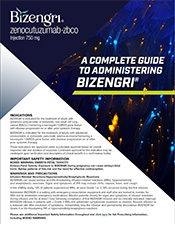


PTx Assist provides comprehensive access and financial support resources for eligible patients to ensure that they receive the care they need to get started and stay on BIZENGRI.v Download the resources below to get started.
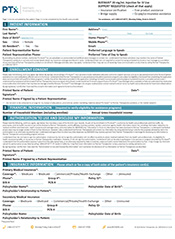
Provided to capture patient, provider, and insurance information for benefit verification and claim adjudication. Also allows the patient to enroll in the PTx Assist program and receive support.
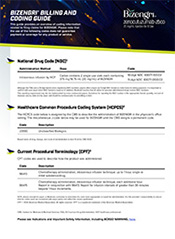
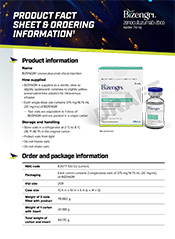
Provides product information, including how BIZENGRI is supplied, storage and handling, and order and package information
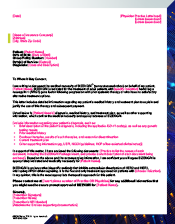
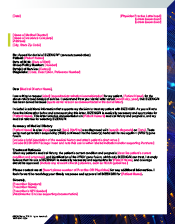




BIZENGRI is indicated for the treatment of adults with advanced unresectable or metastatic non-small cell lung cancer (NSCLC) harboring a neuregulin 1 (NRG1) gene fusion with disease progression on or after prior systemic therapy.
BOXED WARNING: EMBRYO-FETAL TOXICITY
Embryo-Fetal Toxicity: Exposure to BIZENGRI during pregnancy can cause embryo-fetal harm. Advise patients of this risk and the need for effective contraception.
WARNINGS AND PRECAUTIONS
ADCC, antibody-dependent cellular cytotoxicity; AE, adverse event; ALT, alanine aminotransferase; aPTT, activated partial thromboplastin time; AST, aspartate aminotransferase; CHF, congestive heart failure; CPT, Current Procedural Terminology; CR, complete response; DOR, duration of response; FDA, US Food and Drug Administration; GGT, gamma glutamyltransferase; HCPCS, Healthcare Common Procedure Coding System; HER2, human epidermal growth factor receptor 2; HER3, human epidermal growth factor receptor 3; IRR, infusion-related reaction; IV, intravenous; LVEF, left ventricular ejection fraction; mDOR, median duration of response; MedDRA, Medical Dictionary for Regulatory Activities; MOA, mechanism of action; mTOR, mammalian target of rapamycin; NCI CTCAE, National Cancer Institute Common Terminology Criteria for Adverse Events; NDC, National Drug Code; NGS, next-generation sequencing; NRG1+, neuregulin 1 fusion positive; NSCLC, non–small cell lung cancer; ORR, overall response rate; PD-1, programmed cell death protein 1; PD-L1, programmed cell death ligand 1; PI3K, phosphoinositide 3-kinase; PR, partial response; PT, preferred term; Q2W, every 2 weeks.
BIZENGRI is indicated for the treatment of adults with advanced unresectable or metastatic non-small cell lung cancer (NSCLC) harboring a neuregulin 1 (NRG1) gene fusion with disease progression on or after prior systemic therapy.
BIZENGRI is indicated for the treatment of adults with advanced unresectable or metastatic pancreatic adenocarcinoma harboring a neuregulin 1 (NRG1) gene fusion with disease progression on or after prior systemic therapy.
These indications are approved under accelerated approval based on overall response rate and duration of response. Continued approval for these indications may be contingent upon verification and description of clinical benefit in a confirmatory trial(s).
BOXED WARNING: EMBRYO-FETAL TOXICITY
Embryo-Fetal Toxicity: Exposure to BIZENGRI during pregnancy can cause embryo-fetal harm. Advise patients of this risk and the need for effective contraception.
WARNINGS AND PRECAUTIONS
Infusion-Related Reactions/Hypersensitivity/Anaphylactic Reactions
BIZENGRI can cause serious and life-threatening infusion-related reactions (IRRs), hypersensitivity and anaphylactic reactions. Signs and symptoms of IRR may include chills, nausea, fever, and cough.
In the eNRGy study, 13% of patients experienced IRRs, all were Grade 1 or 2; 91% occurred during the first infusion.
Administer BIZENGRI in a setting with emergency resuscitation equipment and staff who are trained to monitor for IRRs and to administer emergency medications. Monitor patients closely for signs and symptoms of infusion reactions during infusion and for at least 1 hour following completion of first BIZENGRI infusion and as clinically indicated. Interrupt BIZENGRI infusion in patients with ≤ Grade 3 IRRs and administer symptomatic treatment as needed. Resume infusion at a reduced rate after resolution of symptoms. Immediately stop the infusion and permanently discontinue BIZENGRI for Grade 4 or life-threatening IRR or hypersensitivity/anaphylaxis reactions.
BIZENGRI can cause serious and life-threatening interstitial lung disease (ILD)/pneumonitis. In the eNRGy study, ILD/pneumonitis occurred in 2 (1.1%) patients treated with BIZENGRI. Grade 2 ILD/pneumonitis (Grade 2) resulting in permanent discontinuation of BIZENGRI occurred in 1 (0.6%) patient. Monitor for new or worsening pulmonary symptoms indicative of ILD/pneumonitis (e.g., dyspnea, cough, fever). Immediately withhold BIZENGRI in patients with suspected ILD/pneumonitis and administer corticosteroids as clinically indicated. Permanently discontinue BIZENGRI if ILD/pneumonitis ≥ Grade 2 is confirmed.
BIZENGRI can cause left ventricular dysfunction.
Left ventricular ejection fraction (LVEF) decrease has been observed with anti-HER2 therapies, including BIZENGRI. Treatment with BIZENGRI has not been studied in patients with a history of clinically significant cardiac disease or LVEF less than 50% prior to initiation of treatment.
In the eNRGy study, Grade 2 LVEF decrease (40%-50%; 10% – 19% drop from baseline) occurred in 2% of evaluable patients. Cardiac failure without LVEF decrease occurred in 1.7% of patients, including 1 (0.6%) fatal event.
Before initiating BIZENGRI, evaluate LVEF and monitor at regular intervals during treatment as clinically indicated. For LVEF of less than 45% or less than 50% with absolute decrease from baseline of 10% or greater which is confirmed, or in patients with symptomatic congestive heart failure (CHF), permanently discontinue BIZENGRI.
Based on its mechanism of action, BIZENGRI can cause fetal harm when administered to a pregnant woman. No animal reproduction studies were conducted with BIZENGRI. In postmarketing reports, use of a HER2-directed antibody during pregnancy resulted in cases of oligohydramnios manifesting as fatal pulmonary hypoplasia, skeletal abnormalities, and neonatal death. In animal models, studies have demonstrated that inhibition of HER2 and/or HER3 results in impaired embryo-fetal development, including effects on cardiac, vascular and neuronal development, and embryolethality. Advise patients of the potential risk to a fetus. Verify the pregnancy status of females of reproductive potential prior to the initiation of BIZENGRI. Advise females of reproductive potential to use effective contraception during treatment with BIZENGRI and for 2 months after the last dose.
NRG1 Gene Fusion Positive Unresectable or Metastatic NSCLC
Serious adverse reactions occurred in 25% of patients with NRG1 Gene Fusion Positive NSCLC who received BIZENGRI. Serious adverse reactions in ≥ 2% of patients included pneumonia (n=4) dyspnea and fatigue (n=2 each). Fatal adverse reactions occurred in 3 (3%) patients and included respiratory failure (n=2), and cardiac failure (n=1). Permanent discontinuation of BIZENGRI due to an adverse reaction occurred in 3% of patients. Adverse reactions resulting in permanent discontinuation of BIZENGRI included dyspnea, pneumonitis and sepsis (n=1 each).
In patients with NRG1 Gene Fusion Positive NSCLC who received BIZENGRI, the most common (>20%) Adverse Reactions, including laboratory abnormalities, were decreased hemoglobin (35%), increased alanine aminotransferase (30%), decreased magnesium (28%), increased alkaline phosphatase (27%), decreased phosphate (26%) diarrhea (25%), musculoskeletal pain (23%), increased gamma-glutamyl transpeptidase (23%), increased aspartate aminotransferase (22%), and decreased potassium (21%).
NRG1 Gene Fusion Positive Unresectable or Metastatic Pancreatic Adenocarcinoma
Serious adverse reactions occurred in 23% of patients with NRG1 Gene Fusion Positive Pancreatic Adenocarcinoma who received BIZENGRI.
There were 2 fatal adverse reactions, one due to COVID-19 and one due to respiratory failure.
In patients with NRG1 Gene Fusion Positive Pancreatic Adenocarcinoma who received BIZENGRI the most common (≥20%) adverse reactions, including laboratory abnormalities, were increased alanine aminotransferase (51%), diarrhea (36%), increased aspartate aminotransferase (31%), increased bilirubin (31%), decreased phosphate (31%), increased alkaline phosphatase (28%), decreased sodium (28%) musculoskeletal pain (28%), decreased albumin (26%), decreased potassium (26%), decreased platelets (26%), decreased magnesium (24%), increased gamma-glutamyl transpeptidase (23%), decreased hemoglobin (23%), vomiting (23%), nausea (23%), decreased leukocytes (21%), and fatigue (21%).
1. BIZENGRI. Prescribing information. Partner Therapeutics, Inc.; 2025.
Please read our Privacy Statement and updated Terms of Use. As described further therein, we use third-party cookies to improve the operation of our site. If you require further information and/or wish to disable cookies, please visit www.allaboutcookies.org.